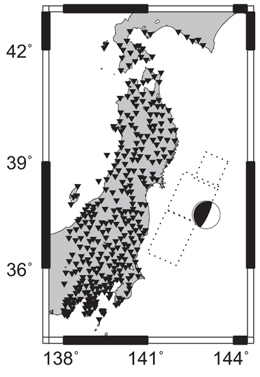Research Abstract
高密度GPSアレイによる2011年東北巨大逆断層地震後の地球自由振動の観測
Observation of Earth's free oscillation by dense GPS array: After the 2011 Tohoku megathrust earthquake
2012年12月5日 Scientific Reports 2 : 931 doi: 10.1038/srep00931

大地震後に日スケールで継続する地球自由振動を検出することは、ひずみ計、重力計および地震計など地中に設置された機器により行われ、地球の内部構造、地球ダイナミクスおよび地震の震源過程を研究するために用いられてきた。本論文では、全球測位システム(GPS)を用いても地球自由振動の信号を検出できることを示す。日本の高密度GPSアレイ(GEONET)は2011年東北巨大逆断層地震の後の地表変形を記録していた。300か所以上の観測点のデータを単純にアレイ解析することで、GPS時系列に含まれる局所的なノイズを低減することが出来る。この高密度GPSアレイは、3方向の変位により伸び縮み振動とねじれ振動の両方を確かに検出できることがわかった。この新しいツールは特に低周波数帯で自由振動を研究する上で大きな可能性を持っている。
三井 雄太1 & 日置 幸介1
- 北海道大学 理学研究院 自然史科学部門
Day-scale Earth's free oscillation after large earthquakes has been detected by underground instruments such as strainmeters, gravimeters and seismometers, to investigate Earth's internal structure, geodynamics, and source properties of earthquakes. Here we show that Global Positioning System (GPS) can also detect the signals of the Earth's free oscillation. A dense GPS array in Japan (GEONET) recorded the surface deformation following the 2011 Tohoku megathrust earthquake. A simple array analysis over 300 stations reduces local noise in GPS time series. We find that the dense GPS array truly detected both spheroidal and toroidal fundamental modes in three-direction displacement. This new tool has a strong potential to investigate the free oscillations particularly in low-frequency bands.

